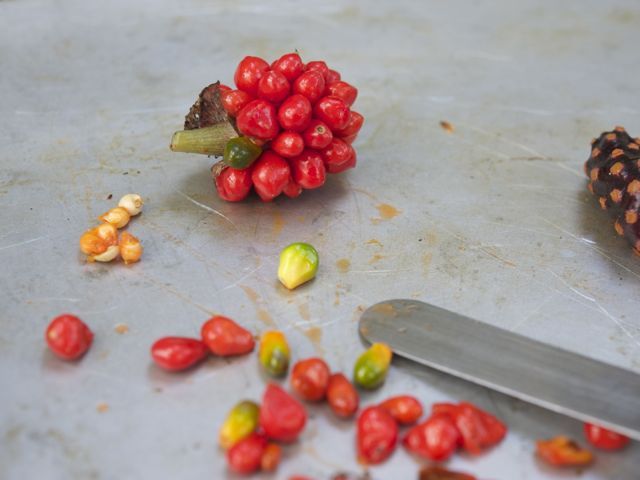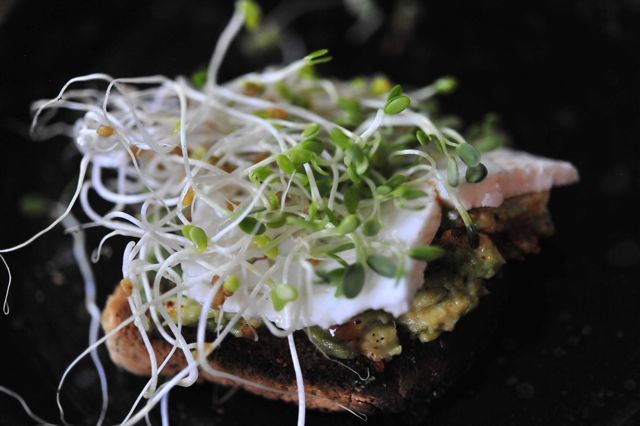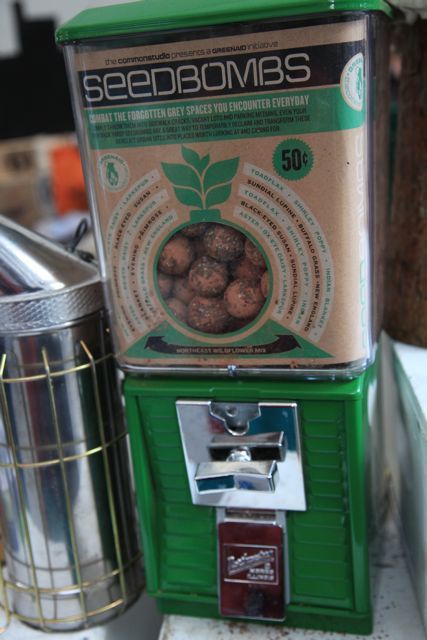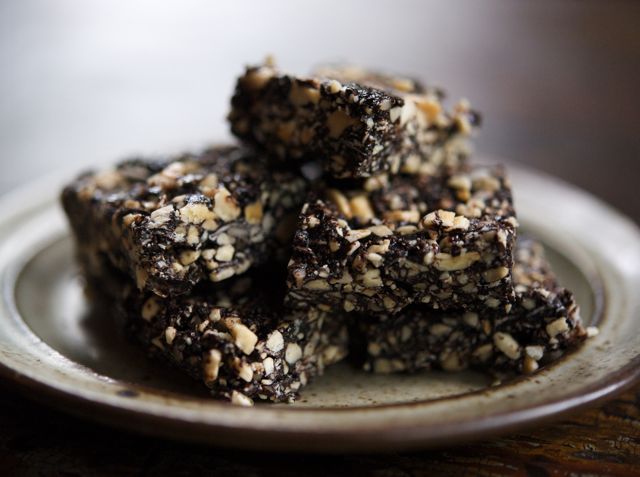10.4.11 Jacked Up
photos by gluttonforlifeAlthough this looks a bit like some exotic fruit, it's actually a seed cluster of the Jack-in-the-Pulpit, variously known as Arisaema triphyllum, bog onion and Indian turnip. This herbaceous perennial grows from a type of corm, not totally dissimilar to crocus and freesia. A highly variable species—some can grow up to 5 feet in height—it's native to eastern North America, found in wet woodlands and thickets, and generally flowers between April and June. Using heat and smell, it attracts the flies responsible for its pollination. The Jack-in-the-Pulpit has a charming, fairy-tale look characterized by its arcing and curving "hood," often with dramatic burgundy stripes on the inside. Its fruit are clusters of smooth, shiny green berries which ripen to a brilliant red in late summer before the plants go dormant. Each berry typically produces between one and five pale-colored rounded seeds. My friend Michael was kind enough to bring me a few scarlet clusters from his plants this season, with instructions to pop each berry "like a zit" to extract the seeds. They need to be planted in a damp, mossy area before the first frost.
Read More...
Read More...
Twitter @glutton4life
3.4.11 Sprouting Wings
Has the light appeared at the end of the tunnel? The days are definitely getting longer. Daylight savings is right around the corner. And soon, delicate shoots and buds will begin to festoon the skeletal branches of winter. But I've got the blues, baby, and I'm dancing as fast as I can to shake them from my weary bones. On mornings like this, the sun on my face is a balm, a promise of better days to come. I thank my stars for the roof over my head and the love of a good man, but there is a heaviness in my soul that, like a magnet, seems to dredge up all the pain and bitter disappointments I have ever known.
This, too, shall pass. Because everything always does. I have no child upon whose steady growth to mark the passage of time, but the ever-changing seasons tell it all. The snowdrifts out my window will give way to Queen Anne's lace and monkeyweed, Japanese beetles will streak by in a flash of iridescence, and I will crush tomato leaves between my dirty fingers and inhale the smell of summer. In the meantime, I will harness the raw energy of the sun, chewing and swallowing it in the form of life-giving sprouts.
Read More...
This, too, shall pass. Because everything always does. I have no child upon whose steady growth to mark the passage of time, but the ever-changing seasons tell it all. The snowdrifts out my window will give way to Queen Anne's lace and monkeyweed, Japanese beetles will streak by in a flash of iridescence, and I will crush tomato leaves between my dirty fingers and inhale the smell of summer. In the meantime, I will harness the raw energy of the sun, chewing and swallowing it in the form of life-giving sprouts.
Read More...
10.8.10 Grass Roots
I remember Union Square before it was lush with may apple and trillium and wild geranium and bushy mountain laurel. I remember when it was full of runaways and junkies and winos—another kind of seedy entirely. This week, G came across this vending machine at the farmers market there. It sells "seedbombs," little nuggets of plant seeds, compost and clay that turn everyone into a guerilla gardener. They're meant to be simply dropped into soil anywhere. Created by design duo Daniel Philips and Kim Karlsrud of Los Angeles-based Common Studio, the seedbomb vending machines help people transform empty outdoor spaces into lush, green communities. Their Northeast Wildflower Mix contains almost two dozen varieties, including Aster,
Purple Coneflower, Sweet Alyssum and Black-Eyed Susan. The vending machines are available to rent or buy, and Common Studio will even develop a seed mix and a strategic neighborhood intervention plan in response to the unique ecologies of your area. Machines can then be installed at local bars, businesses, schools, parks, or anywhere you think they can have the biggest impact.
Read More...
Read More...
6.15.10 Chew On This
Growing up in Santa Cruz, still a hippie mecca to this day, I was exposed early on to all manner of what used to be known as "health foods"—sprouts, carob, smoothies, kefir, whole grain sourdough bread. Maybe that's why I still enjoy trawling about crunchy food co-ops, peering at bags of sesame sticks, bins of millet and containers of powdered spirulina. There is almost always an assortment of carob-covered items (raisins, almonds, ginger) and sometimes these little nuggets, studded with lots of goodies. I love carob's dark, earthy richness; its mild bitterness and distinct winey taste hold up to chocolate's complexity. Carob is a species of flowering evergreen tree in the pea family that is cultivated for its edible seed pods, which are also known as "St. John's bread" because John the Baptist was said to have subsisted on them in the wilderness. Supposedly they also fed Mohammed's armies. The pod can be elongated, compressed, straight or curved and takes a full year to develop and ripen. It is the dried and sometimes roasted pod that we eat, and not the peas or seeds inside. These are called locust beans and are used for animal feed or as the source of locust bean gum, a thickening agent that is an ingredient in many processed foods.
Read More...
Read More...











